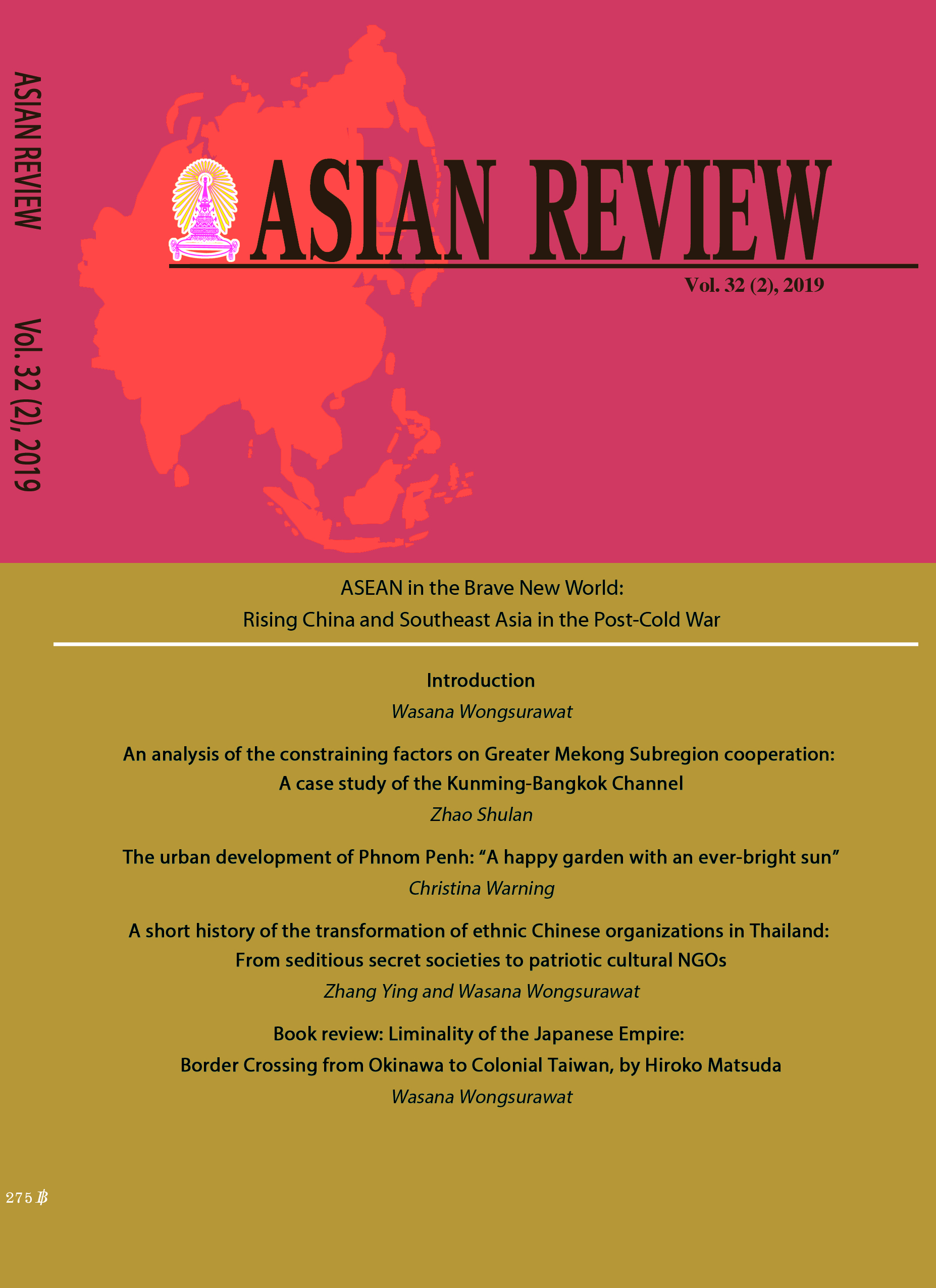An analysis of the constraining factors on Greater Mekong Subregion cooperation: A case study of the Kunming-Bangkok Channel
Keywords:
Kunming-Bangkok Channel, restrictive factors, structural problems, mutual complements in economy, cultural differenceAbstract
Greater Mekong Subregion (GMS) cooperation from the perspective of regional development is restricted by political, economic and cultural factors in the process of promotion. The Kunming-Bangkok corridor is the central line of the GMS SouthNorth Economic Corridor, which was jointly launched by the Asian
Development Bank and China to connect China and ASEAN Countries. But as soon as the Corridor was built in 2013, it was found to be diffi cult to break through the bottleneck of development. Th is can be seen as a common point in diff erent aspects of GMS cooperation. Moreover, the diff erent demands and institutional diff erences of various countries on the Mekong River are political factors that restrict GMS cooperation development. Th e gap between countries
in the level of economic development makes it diffi cult to establish complementarity, resulting in the long-term stagnation of regional cooperation at this stage. In addition, people from diff erent countries in the region have diff erent understandings on development, which makes it diffi cult for regional forces to coordinate and integrate. Although there are various constraints, economic demand will break through the layers of constraint and further promote regional
cooperation, once the door to economic cooperation is opened. To sum up, it is expected there are still broad prospects for the development of the Kunming - Bangkok Corridor between China and Thailand.
References
Chareonwongsak, K. and Chareonwongsak, A. P. 2005. “A Development Gap in the GMS.” In John Dosch, Economic and Non-traditional Security Cooperation in the Greater Mekong Subregion. Singapore: Konrad Adenauer-Stiftung.
Chheang, Vannarith. 2015. China and the Greater Mekong Subregion (GMS) Cooperation. Cambodian Institute for Cooperation and Peace, CICP Working Paper 2015, No.51.
Dosch, Jörn. 2007. Th e Changing Dynamics of Southeast Asian Politics. Boulder: Lynne Rienner Publishers.
Goh, Evelyn. 2007. Developing the Mekong: Regionalism and Regional Security in China-Southeast Asian Relations. London: International Institute for Strategic Studies, Routledge.
Hori Hiroshi. 2000. Th e Mekong: Environment and Development. Tokyo, United Nations University Press.
International Road Transport for the Greater Mekong Subregion (大湄公河次区域国际道路运输启动), May 28 2019, accessed May 30 2019, www.
gov.cn/xinwen/2019-05/28/content_5395319.htm.
Jianxun Kong, et al. 2015. Kunman gongu Diao Cha Bao Gao [Report of Kunming-Bangkok Channel]. Unpublished.
Medhi Krongkaew. 2004. “Th e development of the Greater Mekong Subregion: Real promise fake hope?” Journal of Asian Economics, 15, 5: 977-998.
Mya Th an. 1997. “Economic Cooperation in the Greater Mekong Subregion.” Asian-Pacifi c Economic Literature, 11, 2.
Osborne, Milton. 2000. Th e Mekong: Turbulent Past, Uncertain Future. St Leonards, NSW: Allen and Unwin.
Qichang Li. 2004. Speed up the Construction of the Kunming--Bangkok Highway(N), China Express way, November 17.
Shao Jianping and Liu Ying. 2014. “GMS Cooperation: Th e Impetus to ASEAN Community.” International Forum, 14: 13-18.
Shijie Ribao. 2011. “Taizhong Qianshu Jinchukou Shuiguo Jianyi Xieding” (Agreement between Th ailand and China on the quarantine of imported
and exported fruits), Shijie Ribao (世界日报) 23 April.
Siriluk Masviriyakul. 2004. “Sino-Th ai Strategic Economic Development in the Greater Mekong Subregion (1992-2003).” Contemporary Southeast
Asia, 26, 2: 302-319.
Tiejun Chen. 2003. On the Problem of the Kunming-Bangkok Highway and Our Counter measres. Southeast and South Asia Study.
Verbiest J.-P.A. 2013. “Regional cooperation and integration in the Mekong region.” Asian Economic Policy Review, 8, 1: 148–164.
World Daily (世界日报. 2011. “Agreement between Th ailand and China on the quarantine of imported and exported fruits” (泰中签署进出口水果检疫协定)
Thailand, 23 April.
Downloads
Published
How to Cite
Issue
Section
License
Published articles are under the copyright of the Instiute of Asian Studies, Chulalongkorn University. Partially or totally publication of an article elsewhere is possible only after the consent from the editors.







